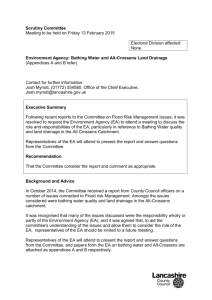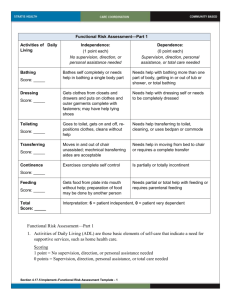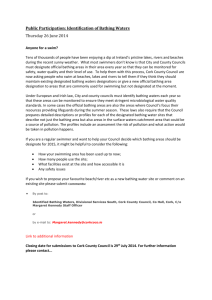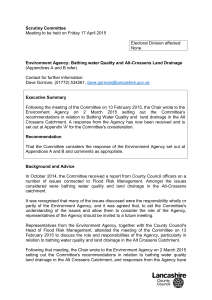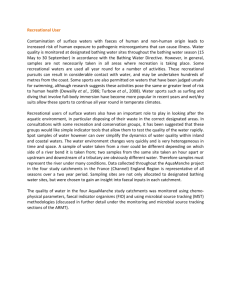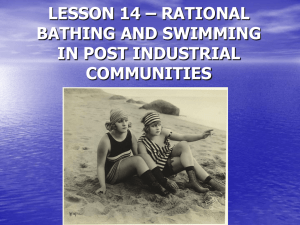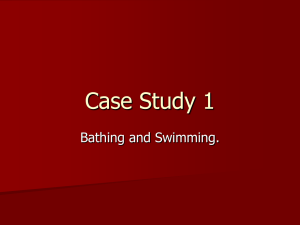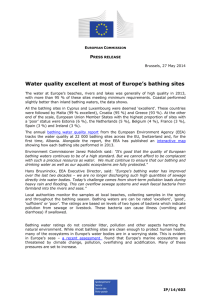Chapter 18. Public Swimming And Bathing Places
advertisement
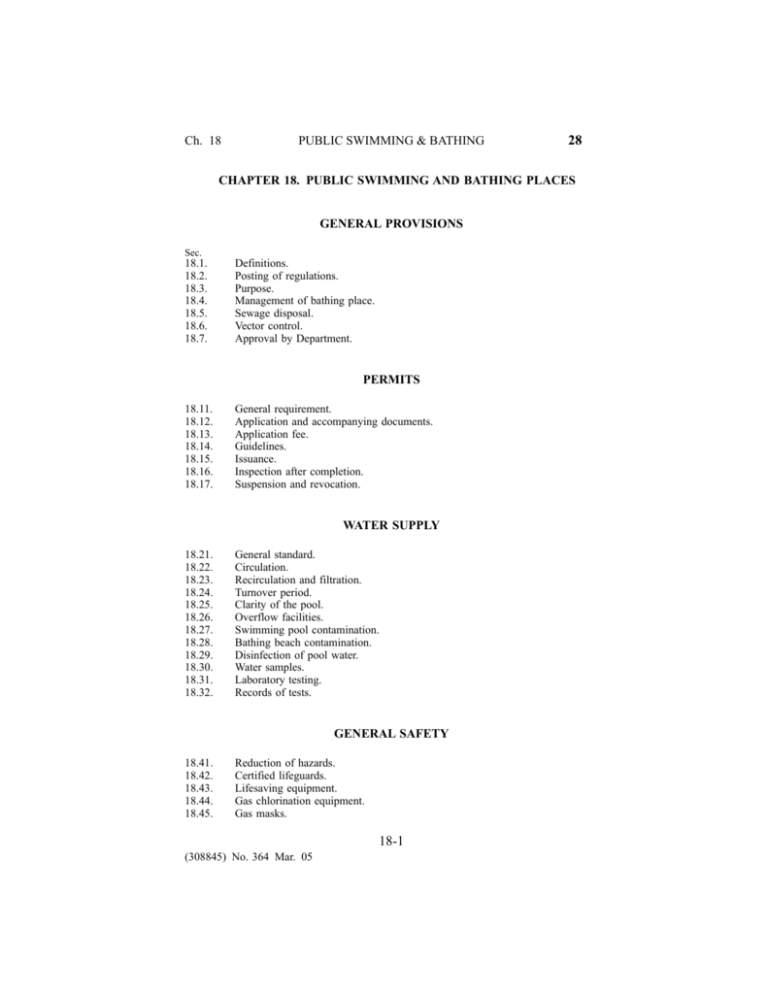
Ch. 18 PUBLIC SWIMMING & BATHING 28 CHAPTER 18. PUBLIC SWIMMING AND BATHING PLACES GENERAL PROVISIONS Sec. 18.1. 18.2. 18.3. 18.4. 18.5. 18.6. 18.7. Definitions. Posting of regulations. Purpose. Management of bathing place. Sewage disposal. Vector control. Approval by Department. PERMITS 18.11. 18.12. 18.13. 18.14. 18.15. 18.16. 18.17. General requirement. Application and accompanying documents. Application fee. Guidelines. Issuance. Inspection after completion. Suspension and revocation. WATER SUPPLY 18.21. 18.22. 18.23. 18.24. 18.25. 18.26. 18.27. 18.28. 18.29. 18.30. 18.31. 18.32. General standard. Circulation. Recirculation and filtration. Turnover period. Clarity of the pool. Overflow facilities. Swimming pool contamination. Bathing beach contamination. Disinfection of pool water. Water samples. Laboratory testing. Records of tests. GENERAL SAFETY 18.41. 18.42. 18.43. 18.44. 18.45. Reduction of hazards. Certified lifeguards. Lifesaving equipment. Gas chlorination equipment. Gas masks. 18-1 (308845) No. 364 Mar. 05 28 LOCAL HEALTH Pt. II HYGIENE 18.51. 18.52. 18.53. 18.54. 18.55. 18.56. General. Employe health. Bather health. Bathing suits and towels. Food. Water. BATHER PREPARATION FACILITIES 18.61. 18.62. 18.63. 18.64. 18.65. 18.66. Requirement. Dressing and toilet facilities. Construction and sanitation. Walls and floors. Lighting. Ventilation and heating. UNSAFE CONNECTIONS 18.71. 18.72. 18.73. Plumbing. Cross connections. Backflow prevention. ELECTRICAL SAFETY 18.81. 18.82. 18.83. 18.84. 18.85. 18.86. 18.87. 18.88. General requirements. Underwater lights. Wiring. Distribution centers. Overhead conductors. Grounding requirements. Location of equipment. Inspection of installations. GARBAGE AND REFUSE 18.91. 18.92. 18.93. 18.94. Collection. Storage. Disposal. Cleaning of area. Authority The provisions of this Chapter 18 issued under the Public Bathing Law (35 P. S. §§ 672—680d); and section 1920-A of The Administrative Code of 1929 (71 P. S. § 510-20), unless otherwise noted. 18-2 (308846) No. 364 Mar. 05 Copyright 娀 2005 Commonwealth of Pennsylvania Ch. 18 PUBLIC SWIMMING & BATHING 28 § 18.1 Source The provisions of this Chapter 18 adopted September 18, 1971, effective September 18, 1971, 1 Pa.B. 1921; renumbered from 25 Pa. Code Chapter 193, June 7, 1996, effective June 8, 1996, 26 Pa.B. 2707, unless otherwise noted. Immediately preceding text appears at serial pages (109693) to (109707). Cross References This chapter cited in 25 Pa. Code § 171.16 (relating to bathing places); 28 Pa. Code § 17.112 (relating to minimum program activities); 55 Pa. Code § 3270.115 (relating to water activity); and 55 Pa. Code § 3280.115 (relating to water activity). GENERAL PROVISIONS § 18.1. Definitions. The following words and terms, when used in this chapter, have the following meanings, unless the context clearly indicates otherwise: Air gap—The unobstructed vertical distance through the free atmosphere between the lowest opening from a pipe or faucet supplying water to a tank, plumbing fixture or other device and the flood level rim of the receptacle. Backflow—The flow of water or other liquids, mixtures or substances into the distributing pipes of a potable supply of water from a source other than the approved source. Bather—A person using a recreational swimming establishment in the water or adjoining deck area for the purpose of swimming, water sports or other recreational activity. Bather load—The total number of bathers in a recreational swimming establishment. Bathing beach—A body of natural water, impounded or flowing, of a size in relation to the bathing load that the quality and quantity, confined or flowing, need be neither mechanically controlled for the purpose of purification nor contained in an impervious structure. Certified lifeguard—An individual who has a current certificate in lifeguarding, issued by a lifeguard certifying authority, as recognized by the Department of Health in a notice published yearly in the Pennsylvania Bulletin. Cross connection—A physical connection or arrangement between two otherwise separate piping systems, one of which contains potable water and the other steam, gas, a chemical or water of unknown or questionable safety, whereby there may be a flow from one system to the other, the direction depending on the pressure differential between the two systems. Department—The Department of Health of the Commonwealth. Garbage—Putrescible wastes, except sewage and body waste, including animal and vegetable offal. Local health department—Each county department of health under the Local Health Administration Law (16 P. S. §§ 12001—12028), and each department 18-3 (308847) No. 364 Mar. 05 28 § 18.1 LOCAL HEALTH Pt. II of health in a municipality approved for a Commonwealth grant to provide local health services under section 25 of the Local Health Administration Law (16 P. S. § 12025). Maximum bather load—The maximum number of bathers that the recreational swimming establishment is designed to accommodate, as defined in the plans and specifications submitted as part of the permit application using the guidelines set forth in the Department’s publication, Public Bathing Place Manual. National Electrical Code—The National Electrical Code published by the National Fire Protection Association, 470 Atlantic Avenue, Boston, Massachusetts 02210. Person—An individual, partnership, corporation, association, municipality, county, authority, the Commonwealth or other private or public entity. Public bathing place—An outdoor or indoor place used for amateur, professional or recreative swimming or bathing whether or not a fee is charged for admission or for the use of the place, exclusive of a bathing place at a private, single-family residence which is used solely by the owner of the residence, his family and their personal guests. Recreational swimming establishment—A facility that is designed, constructed or designated for use by individuals for the primary purpose of swimming, if a fee is charged for admission. (i) The term includes swimming pools, water rides, wave pools and swimming beaches and other outdoor swimming facilities. (ii) The term excludes those facilities owned by condominiums, other property owner associations, rental arrangements that include three or more families or social units, hotels or motels, campgrounds, private clubs and private organizations which do not provide access to the general public, swimming facilities used exclusively for hydrotherapy and residential swimming facilities used solely by the owner of a residence, the owner’s family and personal guests. Refuse—Nonputrescible wastes generally regarded and classified as rubbish, trash, junk and similar designations which have been rejected by the owner or possessor thereof as useless or worthless to him. Rope and float line—A continuous line, at least 1/4 inch in diameter, that is supported by buoys and attached to opposite sides of a swimming pool. Sewage—A substance which contains the waste products or excrements or other discharges from the bodies of human beings or animals and a noxious or deleterious substance being harmful or inimical to the public health, or to animal or aquatic life, or to the use of water for domestic water supply or for recreation. 18-4 (308848) No. 364 Mar. 05 Copyright 娀 2005 Commonwealth of Pennsylvania Ch. 18 PUBLIC SWIMMING & BATHING 28 § 18.2 Sewerage system—A community or individual system, whether publicly or privately owned, for the collection and disposal of sewage or industrial wastes of a liquid nature, including various devices for the treatment of sewage or industrial wastes. Source—A well, spring, cistern, infiltration gallery, stream, reservoir, pond or lake from which, by any means, water is taken either intermittently or continuously for use by the public. Swimming pool—A body of water of a size in relation to the bathing load that the quality and quantity of the water confined must be mechanically controlled for the purpose of purification and contained in an impervious structure. Turnover period—The number of hours required to completely replenish the water in a pool, or recirculate a quantity of water equal to the capacity of the pool. Wading pool—A body of water designed for use by children which is not deeper than 3 feet and of a size in relation to the bathing load that the quality and quantity of the water confined must be mechanically controlled for the purpose of purification and contained in an impervious structure. Waters of this Commonwealth—Rivers, streams, creeks, rivulets, lakes, dammed water, ponds, springs and other bodies of surface and underground water, or parts thereof, whether natural or artificial, within or on the boundaries of this Commonwealth. Water supply—A source or sources of water, as well as, water treatment, storage, transmission and distribution facilities. Authority The provisions of this §18.1 amended under the Public Bathing Law (35 P. S. §§ 672—680d); the Local Health Administration Law (16 P. S. §§ 12001—12028); and section 1920-A of The Administrative Code of 1929 (71 P. S. § 510-20). Source The provisions of this § 18.1 adopted September 18, 1971, effective September 18, 1971, 1 Pa.B. 1921; amended November 29, 1974, effective December 16, 1974, 4 Pa.B. 2453; amended April 29, 1977, effective May 16, 1977, 7 Pa.B. 1172; amended July 16, 2004, effective July 17, 2004, 34 Pa.B. 3695; amended December 30, 2004, effective January 1, 2005, 35 Pa.B. 14. Immediately preceding text appears at serial pages (304621) to (304623). § 18.2. Posting of regulations. A copy of this chapter, as well as the Certificate for Bathing Place, shall be posted conspicuously at the public bathing place for the information of the public. Source The provisions of this § 18.2 adopted September 18, 1971, effective September 18, 1971, 1 Pa.B. 1921; amended November 29, 1974, effective December 16, 1974, 4 Pa.B. 2453. Immediately preceding text appears at serial page (4790). 18-5 (308849) No. 364 Mar. 05 28 § 18.3 LOCAL HEALTH Pt. II § 18.3. Purpose. The purpose of this chapter is to protect the public health through the proper design, operation and maintenance of public bathing places. The design shall be in accordance with sound engineering practice and shall protect the public health and safety. Source The provisions of this § 18.3 adopted September 18, 1971, effective September 18, 1971, 1 Pa.B. 1921; amended November 29, 1974, effective December 16, 1974, 4 Pa.B. 2453. Immediately preceding text appears at serial page (4790). § 18.4. Management of bathing place. (a) A capable manager or caretaker shall be in charge of public bathing places and shall be responsible for the proper maintenance and use of the public bathing place as provided in the Public Bathing Law (35 P. S. §§ 672—680d), the permit issued for the public bathing place and this chapter. (b) The manager or caretaker shall be responsible for maintaining the public bathing place continually in good repair and in a clean, sanitary and healthful manner so that it does not constitute a menace to public health or promote immorality and is not a public nuisance. Source The provisions of this § 18.4 adopted September 18, 1971, effective September 18, 1971, 1 Pa.B. 1921; amended November 29, 1974, effective December 16, 1974, 4 Pa.B. 2453. Immediately preceding text appears at serial page (4790). § 18.5. Sewage disposal. (a) Sewerage systems serving public bathing places shall be approved by the Department. The approval will be based upon satisfactory compliance with Chapter 73 (relating to standards for onlot sewage disposal facilities) and The Clean Streams Law (35 P. S. §§ 691.1—691.1001). (b) Discharge of filter backwash and other pool wastewater to the waters of this Commonwealth shall be approved in the permit. Source The provisions of this § 18.5 adopted September 18, 1971, effective September 18, 1971, 1 Pa.B. 1921; amended November 29, 1974, effective December 16, 1974, 4 Pa.B. 2453. Immediately preceding text appears at serial page (4790). § 18.6. Vector control. Adequate measures for the control of arthropods and rodents which the Department deems a public health hazard shall be taken in a manner satisfactory to the Department. 18-6 (308850) No. 364 Mar. 05 Copyright 娀 2005 Commonwealth of Pennsylvania Ch. 18 PUBLIC SWIMMING & BATHING 28 § 18.7 Source The provisions of this § 18.6 adopted September 18, 1971, effective September 18, 1971, 1 Pa.B. 1921. § 18.7. Approval by Department. A deviation from approved plans or specifications affecting the safety of bathers, treatment process or quality of water shall be approved by the Department in writing before the changes are made. A treatment process or protective measure may not be added to, altered or discontinued without securing appropriate approval from the Department. Source The provisions of this § 18.7 adopted September 18, 1971, effective September 18, 1971, 1 Pa.B. 1921. PERMITS § 18.11. General requirement. A permit shall be obtained from the Department prior to construction or operation of a public bathing place. When the ownership of the public bathing place changes or if the public bathing place is leased by the owner, it is the responsibility of the new owner or lessee to secure a permit issued in his name. Source The provisions of this § 18.11 adopted September 18, 1971, effective September 18, 1971, 1 Pa.B. 1921; amended November 29, 1974, effective December 16, 1974, 4 Pa.B. 2453. Immediately preceding text appears at serial page (4791). Cross References This section cited in 28 Pa. Code § 18.14 (relating to guidelines). 18-6.1 (308851) No. 364 Mar. 05 18-6.2 (308852) No. 364 Mar. 05 Copyright 娀 2005 Commonwealth of Pennsylvania Ch. 18 PUBLIC SWIMMING & BATHING 28 § 18.12 § 18.12. Application and accompanying documents. (a) The application for a permit shall be accompanied by the submission of plans, specifications, designer’s report and other data which may be needed to enable the Department to determine compliance with its requirements. (b) Drawings, specifications and the report of the designer submitted as part of the application shall be prepared by or under the supervision of a registered professional engineer or registered architect legally qualified to practice in this Commonwealth. (c) The front cover or flyleaf of each set of drawings, of each copy of the designer’s report, and of the specifications submitted shall bear the signature and the imprint of the seal of the registered engineer or architect by or under whom prepared. Each drawing shall bear an imprint or a legal facsimile of the seal. Source The provisions of this § 18.12 adopted September 18, 1971, effective September 18, 1971, 1 Pa.B. 1921. Cross References This section cited in 28 Pa. Code § 18.14 (relating to guidelines). § 18.13. Application fee. Each application shall be accompanied by a fee of $10 payable to the ‘‘Commonwealth of Pennsylvania.’’ Source The provisions of this § 18.13 adopted September 18, 1971, effective September 18, 1971, 1 Pa.B. 1921. Cross References This section cited in 28 Pa. Code § 18.14 (relating to guidelines). § 18.14. Guidelines. The Department’s pamphlet, Bathing Place Manual, Bureau of Sanitary Engineering Publication No. 16, may be used as a guide for determining compliance with §§ 18.11—18.17 (relating to permits). Source The provisions of this § 18.14 adopted September 18, 1971, effective September 18, 1971, 1 Pa.B. 1921. Notes of Decisions Condominium swimming pools for private use by the residents are excluded from Department of Environmental Resources’ permit requirements under the Public Bathing Law (35 P. S. §§ 672— 680d). Nemacolin, Inc. v. Department of Environmental Resources, 541 A.2d 811 (Pa. Cmwlth. 1988). 18-7 (304625) No. 358 Sep. 04 28 § 18.15 LOCAL HEALTH Pt. II § 18.15. Issuance. Construction of public bathing places, additions and alterations may start only upon issuance and receipt of a permit and shall be in compliance with plans, designs and other data approved by the Department. Source The provisions of this § 18.15 adopted September 18, 1971, effective September 18, 1971, 1 Pa.B. 1921. Cross References This section cited in 28 Pa. Code § 18.14 (relating to guidelines). § 18.16. Inspection after completion. The permittee shall notify the Department at the time of completion of the construction of the public bathing place to permit inspection before the public bathing place is placed in operation. Source The provisions of this § 18.16 adopted September 18, 1971, effective September 18, 1971, 1 Pa.B. 1921; amended November 29, 1974, effective December 16, 1974, 4 Pa.B. 2453. Immediately preceding text appears at serial page (4792). Cross References This section cited in 28 Pa. Code § 18.14 (relating to guidelines). § 18.17. Suspension and revocation. A permit may be suspended or revoked for failure to comply with this chapter. Source The provisions of this § 18.17 adopted September 18, 1971, effective September 18, 1971, 1 Pa.B. 1921. Cross References This section cited in 28 Pa. Code § 18.14 (relating to guidelines). WATER SUPPLY § 18.21. General standard. The water used at public bathing places for swimming or recreative bathing shall meet the bacteriological, chemical, physical and radiological standards of the Department. Source The provisions of this § 18.21 adopted September 18, 1971, effective September 18, 1971, 1 Pa.B. 1921; amended November 29, 1974, effective December 16, 1974, 4 Pa.B. 2453. Immediately preceding text appears at (4792). 18-8 (304626) No. 358 Sep. 04 Copyright 娀 2004 Commonwealth of Pennsylvania Ch. 18 PUBLIC SWIMMING & BATHING 28 § 18.22 § 18.22. Circulation. Water shall be introduced to and withdrawn from the pool in a manner that provides uniform circulation and uniform disinfectant residual throughout the entire pool. Source The provisions of this § 18.22 adopted September 18, 1971, effective September 18, 1971, 1 Pa.B. 1921. Cross References This section cited in 28 Pa. Code § 18.23 (relating to recirculation and filtration). § 18.23. Recirculation and filtration. (a) A pool shall be provided with a recirculation and filtration system, except when there is a flow of water of the quality and quantity through the pool which at all times conforms to §§ 18.22—18.29. (b) When sand or anthrafilt filters are used, equipment shall be provided capable of continuously adding with reasonable accurate dosage, coagulant ahead of the filters. Source The provisions of this § 18.23 adopted September 18, 1971, effective September 18, 1971, 1 Pa.B. 1921. § 18.24. Turnover period. The turnover period for wading pools may not be longer than 2 hours, and the turnover period for other types of pools may not be longer than 8 hours. Source The provisions of this § 18.24 adopted September 18, 1971, effective September 18, 1971, 1 Pa.B. 1921. Cross References This section cited in 28 Pa. Code § 18.23 (relating to recirculation and filtration). § 18.25. Clarity of the pool. Water in the pool shall be sufficiently clear to permit a black disc, 6 inches in diameter on a white field, when placed on the bottom of the pool at the deepest point, to be clearly visible from the runway or deck around the deep area of the pool. Source The provisions of this § 18.25 adopted September 18, 1971, effective September 18, 1971, 1 Pa.B. 1921. 18-9 (304627) No. 358 Sep. 04 28 § 18.26 LOCAL HEALTH Pt. II Cross References This section cited in 28 Pa. Code § 18.23 (relating to recirculation and filtration). § 18.26. Overflow facilities. Overflow facilities shall be provided and water levels in the pool maintained to effectively remove scum, debris or other floating matter. Source The provisions of this § 18.26 adopted September 18, 1971, effective September 18, 1971, 1 Pa.B. 1921. Cross References This section cited in 28 Pa. Code § 18.23 (relating to recirculation and filtration). § 18.27. Swimming pool contamination. The water in a swimming pool or wading pool shall be considered contaminated when one of the following conditions exist: (1) More than one 10-milliliter portion of a sample shows a positive test for coliform organisms when multitube fermentation technique is used or more than one coliform per 50 milliliters when the membrane filter test is used. (2) Two consecutive samples show a positive test for coliform organisms in any 10-milliliter portion of a sample when the multitube fermentation technique is used or more than one coliform per 50 milliliters when the membrane filter test is used. (3) Two of any 10 consecutive samples show a positive test for coliform organisms in any of the 10-milliliter portions of a sample when the multitube fermentation technique is used or more than one coliform per 50 milliliters when the membrane filter test is used. Source The provisions of this § 18.27 adopted September 18, 1971, effective September 18, 1971, 1 Pa.B. 1921. Cross References This section cited in 28 Pa. Code § 18.23 (relating to recirculation and filtration); and 28 Pa. Code §18.30 (relating to water samples). § 18.28. Bathing beach contamination. (a) Use of a bathing beach found to be contaminated shall be discontinued until written approval to reopen the bathing beach for swimming or bathing is obtained from the Department. The permittee shall prominently post legible signs measuring at least 8⬙ by 11⬙ at all entrances to the bathing beach area informing the public that the bathing beach is closed and that swimming or bathing is prohibited. The approval will be given by the Department when the Department finds that the waters of the bathing beach are no longer contaminated. 18-10 (304628) No. 358 Sep. 04 Copyright 娀 2004 Commonwealth of Pennsylvania Ch. 18 PUBLIC SWIMMING & BATHING 28 § 18.29 (b) The water in bathing beaches will be considered contaminated for bathing purposes when one of the following conditions exists: (1) The Department determines that a substance is being discharged or may be discharged into the water and is or may be hazardous to the health of persons using the bathing beach. (2) The E. coli density of a water sample taken from the bathing beach exceeds 235 per 100 milliliters. (3) The E. coli density in all water samples taken from the bathing beach, in any 30-day period during the bathing beach’s operating season, exceeds a geometric mean of 126 per 100 milliliters. Authority The provisions of this § 18.28 amended under the Public Bathing Law (35 P. S. §§ 672—680d); the Local Health Administration Law (16 P. S. §§ 12001—12028); and section 1920-A of The Administrative Code of 1929) (71 P. S. § 510-20). Source The provisions of this § 18.28 adopted September 18, 1971, effective September 18, 1971, 1 Pa.B. 1921; amended June 19, 1981, effective June 20, 1981, 11 Pa.B. 2133; amended July 16, 2004, effective July 17, 2004, 34 Pa.B. 3695. Immediately preceding text appears at serial pages (216884) to (216885). Cross References This section cited in 28 Pa. Code § 18.23 (relating to recirculation and filtration); and 28 Pa. Code § 18.30 (relating to water samples). § 18.29. Disinfection of pool water. (a) When chlorine or a hypochlorite compound is used for disinfection, the free chlorine residual in the water in all parts of the pool when in use shall be at least 0.4 milligram per liter and the pH value of the water shall be at least 7.2 and not more than 8.2. (b) Other disinfecting materials or methods may be used after approval by the Department when they have been adequately demonstrated to: (1) Provide a satisfactory residual effect which is easily measured. (2) Work as effectively as the chlorine concentrations required by subsection (a). (3) Create no danger to public health, create no objectionable physiological effects, or impart no toxic properties to the water. (c) Testing kits shall be provided for making the necessary tests for residual disinfection and pH. The kit for disinfectant residual shall be accurate within 0.1 milligram per liter of chlorine or equivalent. The pH kit shall be accurate within 0.2 pH units. When the pool is in use tests shall be made at least twice daily or more often if required by the Department. 18-11 (304629) No. 358 Sep. 04 28 § 18.30 LOCAL HEALTH Pt. II Source The provisions of this § 18.29 adopted September 18, 1971, effective September 18, 1971, 1 Pa.B. 1921. Cross References This section cited in 28 Pa. Code § 18.23 (relating to recirculation and filtration). § 18.30. Water samples. (a) The permittee shall be responsible for the collection and examination of samples for the purity of the water used for swimming or bathing. The samples shall be examined by a laboratory which complies with § 18.31 (relating to laboratory testing). (b) A sample shall be taken within 1 week prior to the opening of the bathing beach for the season. (c) The permittee shall have a bacteriological analysis made at least once each week of a sample collected during the period of maximum use of the public bathing place. The permittee shall furnish additional analyses of samples as described under subsection (d)(3) upon written notification by the Department. (d) Bathing water shall be sampled in accordance with the following requirements: (1) Each sample shall be taken from water that is approximately 30 inches deep and at a midpoint between the bottom and the surface of the water. (2) Each sample shall be tested individually for E. coli in accordance with § 18.31. (3) The Department may require additional samples be taken based upon the size of the bathing area, bather loads, weather conditions, the bacteriological history of the water, as well as other factors that may influence the quality of the water. (e) For a bathing beach located on Lake Erie, the bathing water shall be sampled in accordance with subsections (a), (b) and (d) and the following additional requirements: (1) At least three samples of water shall be taken from each beach at least once a week. One sample shall be taken from approximately 50 feet from each end of the beach and the third sample shall be taken from the center of the beach. (2) The arithmetic mean of the three samples from each beach shall be used to determine if the beach water is contaminated using the standards described in § 18.28 (relating to bathing beach contamination). (3) A sample may not be taken when the beach is closed due to high wave activity, but shall be taken the day the beach is reopened for swimming and bathing. (4) The Erie County Department of Health may impose additional requirements that are equal to or more stringent than the requirements of this section. 18-12 (304630) No. 358 Sep. 04 Copyright 娀 2004 Commonwealth of Pennsylvania Ch. 18 PUBLIC SWIMMING & BATHING 28 § 18.31 (f) For a swimming pool, specialty pool, spa and hot tub the bathing water shall be sampled at least once a week from the area of average depth, in accordance with § 18.27 (relating to swimming pool contamination). (g) Copies of reports of analyses shall be maintained by the permittee for at least 2 years and made available to the Department upon request. (h) The laboratory conducting the bacteriological testing shall report test results exceeding the criteria specified in §§ 18.27 and 18.28 to the appropriate district office of the Department or the local health department within 24 hours of the availability of the laboratory result. Authority The provisions of this § 18.30 amended under the Public Bathing Law (35 P. S. §§ 672—680d); the Local Health Administration Law (16 P. S. §§ 12001—12028); and section 1920-A of The Administrative Code of 1929) (71 P. S. § 510-20). Source The provisions of this § 18.30 adopted September 18, 1971, effective September 18, 1971, 1 Pa.B. 1921; amended November 29, 1974, effective December 16, 1974, 4 Pa.B. 2453; amended July 16, 2004, effective July 17, 2004, Pa.B. 3695. Immediately preceding text appears at serial pages (216885) to (216886). § 18.31. Laboratory testing. (a) Testing and analysis of water samples shall be performed by competent personnel at a drinking water environmental laboratory that is required to register with the Department of Environmental Protection and is in compliance with 27 Pa.C.S. Chapter 41 (relating to environmental laboratory accreditation), known as the Environmental Laboratory Accreditation Act, and the regulations promulgated thereunder. Testing of the water samples shall be performed in accordance with the procedure provided in the Standard Methods for the Examination of Water and Wastewater, 20th edition, published jointly by the American Public Health Association and the American Water Works Association, as amended, or in accordance with any other method approved by the United States Environmental Protection Agency for the testing of E. coli in water samples taken from waters designated for primary contact recreation. (b) The laboratory shall document the method used to complete the tests of the water samples and make the documentation available to the Department upon request. Authority The provisions of this § 18.31 amended under the Public Bathing Law (35 P. S. §§ 672—680d); the Local Health Administration Law (16 P. S. §§ 12001—12028); and section 1920-A of The Administrative Code of 1929) (71 P. S. § 510-20). 18-13 (308853) No. 364 Mar. 05 28 § 18.32 LOCAL HEALTH Pt. II Source The provisions of this § 18.31 adopted September 18, 1971, effective September 18, 1971, 1 Pa.B. 1921; amended July 16, 2004, effective July 17, 2004, 34 Pa.B. 3695. Immediately preceeding text appears at serial page (216886). Cross References This section cited in 28 Pa. Code § 18.30 (relating to water samples). § 18.32. Records of tests. Daily records of tests and of the operation of the public bathing place shall be kept on forms satisfactory to the Department and copies thereof shall be filed monthly, or more often if required, with the appropriate office of the Department or county health department. Source The provisions of this § 18.32 adopted September 18, 1971, effective September 18, 1971, 1 Pa.B. 1921; amended November 29, 1974, effective December 16, 1974, 4 Pa.B. 2453. Immediately preceding text appears at serial page (4796). GENERAL SAFETY § 18.41. Reduction of hazards. Construction, equipment, operation and maintenance at public bathing places shall be such as to reduce to a practical minimum the danger of injury to persons from drowning, falls, collisions, fires, nuisances or hazard of any kind. Source The provisions of this § 18.41 adopted September 18, 1971, effective September 18, 1971, 1 Pa.B. 1921; amended November 29, 1974, effective December 16, 1974, 4 Pa.B. 2453. Immediately preceding text appears at serial page (4796). § 18.42. Certified lifeguards. (a) Recognized lifeguard certifying authorities. The Department recognizes the American Red Cross, the YMCA and Jeff Ellis and Associates, Inc. as lifeguard certifying authorities. (1) Other organizations that intend to qualify as certifying authorities shall submit materials, on an annual basis, to the Department to establish that their lifeguard training courses satisfy the criteria in subsection (b). (2) The materials shall be submitted to the Department on or before June 30 of each year and shall include a completed form entitled ‘‘Application for Recognition as a Lifeguard Certifying Authority’’ in the submission. (3) This form is available from the Department. (4) The Department will publish a list of approved certifying authorities annually, on or before December 1 of each year, in the Pennsylvania Bulletin. 18-14 (308854) No. 364 Mar. 05 Copyright 娀 2005 Commonwealth of Pennsylvania Ch. 18 PUBLIC SWIMMING & BATHING 28 § 18.42 (b) Requirements for a lifeguard certifying authority. The Department will consider approval of a lifeguard certifying authority if the certifying authority’s lifeguard training course satisfies the following requirements: (1) The course is conducted pursuant to a written training plan, instructor’s manual and text book. (2) The course provides for confirmation of course completion for certification in cardiopulmonary resuscitation. (3) The course provides for certification in first aid. (4) The course includes a system for evaluating swimming ability. (5) The course provides for instruction in lifeguarding responsibilities. (6) The course provides a method for testing and certification. (7) The course includes a certificate which expires, in no longer than 3 years, if renewal criteria are not satisfied. (8) The instructors of the course have successfully completed a training course that includes: (i) Certification in lifeguard instruction. (ii) Student evaluation. (iii) Program planning. (iv) Cardiopulmonary resuscitation. (v) Conducting practice first aid and rescue sessions. (c) Required number of lifeguards. A recreational swimming establishment shall have on duty an adequate number of certified lifeguards to protect the safety of users. To ensure an adequate number of certified lifeguards, the operator of a recreational swimming establishment shall comply with the following requirements: (1) At least one certified lifeguard for every 4,000 square feet of water surface area, plus one certified lifeguard for any fraction thereof, equal to or greater than 1,000 square feet, shall be on duty at the waterside at all times the recreational swimming establishment is open to use by bathers for general swim purposes. At no time may there be less than two certified lifeguards present and available to aid bathers when the recreational swimming establishment is open to the general public for recreational swimming. (i) The water surface area means the total surface area of water accessible to the bathers, including any wading pools. (ii) The operator may reduce the water surface area by closing portions of the swimming area with a rope and float line, provided that the operator maintains adequate notification and supervision to prevent patrons from entering the closed portions of the swimming area. For the purposes of this section, ‘‘adequate’’ means sufficient to accomplish the task, but it does not require any additional certified lifeguards above the minimum number established in this section. (iii) Under circumstances when the ability of a certified lifeguard to survey 4,000 square feet of water surface area is impaired, such as when the size 18-14.1 (308855) No. 364 Mar. 05 28 § 18.42 LOCAL HEALTH Pt. II or shape, or both, of the recreational swimming establishment prevents the certified lifeguard from monitoring the assigned area from a designated location, the Department may require additional certified lifeguards to assure the safety of the bathers. (2) The bather load of the recreational swimming establishment may not exceed the maximum bather load as defined in the permit application. (3) During periods when swim meets, swim team practices, learn-to-swim programs, lifeguard training, or other special events in which the use of the recreational swimming establishment is restricted to only those persons participating in the special events, at least one certified lifeguard, whose sole duty is to protect the bathers, shall be present at waterside during the event. (4) When a wading pool is open to the public, the certified lifeguard shall have an unobstructed view of the entire wading pool from a certified lifeguard’s assigned station. If the certified lifeguard does not have an unobstructed view, an additional certified lifeguard shall be on duty to guard only the wading pool. (5) If the recreational swimming establishment has a diving board or water slide, a certified lifeguard shall be on duty to monitor the diving well or catch area when the diving board or water slide is open to the public. (i) The certified lifeguard shall be stationed within 50 feet of the diving well or slide catch area. (ii) If the swimming area includes both a diving well and slide catch area, or the recreational swimming establishment has multiple slides or diving boards, the operator may not assign a certified lifeguard to monitor both areas unless that lifeguard is stationed within 50 feet of each and can monitor both areas simultaneously. (iii) If the diving well or slide catch area is physically separated from the main swimming area, a certified lifeguard shall be assigned to monitor the diving well or slide catch area exclusively, and the operator shall exclude the water surface area of the diving well or slide catch area from the water surface area of the recreational swimming establishment for the purpose of determining the number of additional certified lifeguards required under paragraph (1). (6) While on duty to watch bathers, a certified lifeguard may not be assigned other tasks which may divert attention from the safety of the bathers, or which are outside the lifeguard’s training and certification. (d) Violation of certified lifeguard requirement. The Department may order to be closed to the public any recreational swimming establishment that it finds to be in violation of any of the provisions of subsection (c), until the Department has done the following: (1) Performed a follow-up inspection. (2) Found that the facility has met the requirements of subsection (c). (3) Provided that facility with written authorization to reopen. 18-14.2 (308856) No. 364 Mar. 05 Copyright 娀 2005 Commonwealth of Pennsylvania Ch. 18 PUBLIC SWIMMING & BATHING 28 § 18.42 Source The provisions of this § 18.42 amended November 29, 1974, effective December 16, 1974, 4 Pa.B. 2453; amended December 30, 2004, effective January 1, 2005, 35 Pa.B. 14. Immediately preceding text appears at serial pages (304632) to (304633). 18-14.3 (308857) No. 364 Mar. 05 18-14.4 (308858) No. 364 Mar. 05 Copyright 娀 2005 Commonwealth of Pennsylvania Ch. 18 PUBLIC SWIMMING & BATHING 28 § 18.43 Notes of Decisions Parents of handicapped student who drowned in an unguarded pool failed to satisfy ‘‘dangerous condition of realty’’ exception to governmental immunity absent showing artificial condition or defects of land itself. Musheno v. Lock Haven University of Pennsylvania, 574 A.2d 129 (Pa. Cmwlth. 1990). The Supreme Court affirmed the Commonwealth Court unreported opinion and order on motions for judgment on the pleadings which declared 25 Pa. Code § 193.42 (later redesignated 28 Pa. Code § 18.42) invalid and beyond the power granted to the Department of Environmental Resources. Spooner v. Secretary of Commonwealth, 574 A.2d 600 (Pa. 1990). § 18.43. Lifesaving equipment. The following minimum lifesaving and first aid equipment shall be provided and shall be readily available for emergency use at each public bathing place: (1) Reaching devices. One or more reaching devices. These devices may include, but are not limited to, poles, ropes and reasonable means to extend a person’s reach. (2) Flotation devices. One or more buoys, life jackets or flotation devices that can support an adult in water. (3) First aid kit. A standard 24-unit first aid kit, filled and readily accessible for emergency use. Source The provisions of this § 18.43 adopted September 18, 1971, effective September 18, 1971, 1 Pa.B. 1921; amended June 19, 1981, effective June 20, 1981, 11 Pa.B. 2133. Immediately preceding text appears at serial page (18984). § 18.44. Gas chlorination equipment. If gas chlorination equipment is installed at either outdoor or indoor pools, the equipment shall be housed in a separate room equipped with an exhaust fan to reduce to a minimum the possibility of gas leakage into other rooms or areas where persons gather. Source The provisions of this § 18.44 adopted September 18, 1971, effective September 18, 1971, 1 Pa.B. 1921. § 18.45. Gas masks. (a) Where gas chlorination equipment is installed, a gas mask designed for use in a chlorine atmosphere and of a type approved by the National Institute of Occupational Safety and Health; Parklawn Building; 5600 Fisher Lane; Rockville, Maryland 20852 shall be provided. (b) A replacement cannister shall be provided with the gas mask. (c) A record shall be kept of gas mask usage to insure that the mask will be serviceable when needed. 18-15 (304633) No. 358 Sep. 04 28 § 18.51 LOCAL HEALTH Pt. II (d) The gas mask shall be kept in a closed cabinet, accessible without a key, located outside the room in which the chlorinator is maintained. Source The provisions of this § 18.45 adopted September 18, 1971, effective September 18, 1971, 1 Pa.B. 1921; amended June 19, 1981, effective June 20, 1981, 11 Pa.B. 2133. Immediately preceding text appears at serial page (18985). HYGIENE § 18.51. General. The common use of drinking cups, towels, hairbrushes or other toilet articles is prohibited. Source The provisions of this § 18.51 adopted September 18, 1971, effective September 18, 1971, 1 Pa.B. 1921. § 18.52. Employe health. A person having a disease in a stage which is communicable or likely to become so, may not be employed at a public bathing place. Source The provisions of this § 18.52 adopted September 18, 1971, effective September 18, 1971, 1 Pa.B. 1921. § 18.53. Bather health. Persons with signs of illness or disease or with skin rashes or sores or with bandages shall be excluded from public bathing places, except when certified by a physician not to have a disease in a communicable stage. Source The provisions of this § 18.53 adopted September 18, 1971, effective September 18, 1971, 1 Pa.B. 1921. § 18.54. Bathing suits and towels. Bathing suits and towels furnished to bathers shall be thoroughly cleaned and dried each time they are used in a manner that precludes the transmission of disease, and they shall be stored in a clean and sanitary manner. Source The provisions of this § 18.54 adopted September 18, 1971, effective September 18, 1971, 1 Pa.B. 1921. 18-16 (304634) No. 358 Sep. 04 Copyright 娀 2004 Commonwealth of Pennsylvania Ch. 18 PUBLIC SWIMMING & BATHING 28 § 18.55 § 18.55. Food. If food service is provided, the food service facilities and operations shall comply with 7 Pa. Code Chapter 78 (Reserved). Source The provisions of this § 18.55 adopted September 18, 1971, effective September 18, 1971, 1 Pa.B. 1921. § 18.56. Water. (a) Water used for drinking, food preparation, cleaning or personal hygiene purposes at public bathing places shall be provided from a supply approved by the Department. The approval shall be based upon satisfactory compliance with the construction standards for water supplies approved by the Department and the following: (1) The water supply shall be adequate in quantity and shall meet the bacteriological and chemical water standards of the Department. (2) An unapproved water supply shall be made inaccessible to the public in a manner deemed satisfactory to the Department. (b) Drinking water facilities shall be provided at public bathing places. Source The provisions of this § 18.56 adopted September 18, 1971, effective September 18, 1971, 1 Pa.B. 1921; amended November 29, 1974, effective December 16, 1974, 4 Pa.B. 2453. Immediately preceding text appears at serial page (4799). BATHER PREPARATION FACILITIES § 18.61. Requirement. Adequate bather preparation facilities shall be available to users of the public bathing place. Source The provisions of this § 18.61 adopted September 18, 1971, effective September 18, 1971, 1 Pa.B. 1921; amended November 29, 1974, effective December 16, 1974, 4 Pa.B. 2453. Immediately preceding text appears at serial page (4799). § 18.62. Dressing and toilet facilities. Bather preparation facilities shall be provided with separate dressing facilities, showers, lavatories, toilets and appurtenances for each sex unless the facilities are otherwise readily available to users of the public bathing place, except that dressing facilities and showers may not be required at bathing beaches. 18-17 (304635) No. 358 Sep. 04 28 § 18.63 LOCAL HEALTH Pt. II Source The provisions of this § 18.62 adopted September 18, 1971, effective September 18, 1971, 1 Pa.B. 1921; amended November 29, 1974, effective December 16, 1974, 4 Pa.B. 2453. Immediately preceding text appears at serial page (4799). § 18.63. Construction and sanitation. Bather preparation facilities shall be designed and constructed so that good sanitation may be maintained throughout the building at all times and so that injury to the bather is reduced to a practical minimum. Source The provisions of this § 18.63 adopted September 18, 1971, effective September 18, 1971, 1 Pa.B. 1921. § 18.64. Walls and floors. Interior walls and floors shall be surfaced with material which is readily cleanable and the floors drained to prevent standing water. Source The provisions of this § 18.64 adopted September 18, 1971, effective September 18, 1971, 1 Pa.B. 1921. § 18.65. Lighting. Sufficient lighting shall be provided to promote cleanliness. Source The provisions of this § 18.65 adopted September 18, 1971, effective September 18, 1971, 1 Pa.B. 1921. § 18.66. Ventilation and heating. Ventilation and heating shall be such as to provide for the comfort of the bather. Source The provisions of this § 18.66 adopted September 18, 1971, effective September 18, 1971, 1 Pa.B. 1921. UNSAFE CONNECTIONS § 18.71. Plumbing. Plumbing shall be sized, installed and maintained to carry adequate quantities of water to required locations throughout the public bathing place, to prevent contamination of the water supply, to properly convey sewage and liquid wastes from the establishment to the sewerage or sewage disposal system and to prevent creation of an unsanitary condition or nuisance. 18-18 (304636) No. 358 Sep. 04 Copyright 娀 2004 Commonwealth of Pennsylvania Ch. 18 PUBLIC SWIMMING & BATHING 28 § 18.72 Source The provisions of this § 18.71 adopted September 18, 1971, effective September 18, 1971, 1 Pa.B. 1921; amended November 29, 1974, effective December 16, 1974, 4 Pa.B. 2453. Immediately preceding text appears at serial page (4800). § 18.72. Cross connections. (a) Cross connections are not permitted. (b) A cross connection is considered broken if a minimum air gap of at least twice the diameter of the water pipe is provided where potable water enters the pool and where pool water or water from the recirculation system is discharged to a sewer system. Source The provisions of this § 18.72 adopted September 18, 1971, effective September 18, 1971, 1 Pa.B. 1921. § 18.73. Backflow prevention. (a) Backflow is not permitted. A potable water distributing pipe is considered as protected against backflow from a plumbing fixture or other piece of equipment or from an appliance capable of affecting the quality of the water in the potable water supply where an air gap of at least twice the diameter of the water supply pipe has been provided. (b) Where it is not practicable to provide the minimum air gap, the connection to the fixture, equipment or appliance shall be equipped with a backflow preventer assembly of a type and at a location approved by the Department. (c) The Department may require that a backflow preventer assembly of a type and location approved by the Department be installed at a fixed potable water outlet to which a hose may be connected and used in contact with liquids or other substances. Source The provisions of this § 18.73 adopted September 18, 1971, effective September 18, 1971, 1 Pa.B. 1921. ELECTRICAL SAFETY § 18.81. General requirements. Except where otherwise noted, the following requirements apply to electrical equipment and wiring at public bathing places: (1) The installation and subsequent addition to or modification of electrical equipment or wiring at bathing beaches shall comply with and be maintained in accordance with the requirements of the edition of the National Electrical Code in effect at the time of the installation, addition or modification. 18-19 (304637) No. 358 Sep. 04 28 § 18.82 LOCAL HEALTH Pt. II (2) The installation and subsequent addition to or modification of electrical equipment and wiring at swimming pools shall comply with and be maintained in accordance with the requirements of the edition of the National Electrical Code in effect at the time of the installation, addition or modification, provided that installation, modification or addition of electrical equipment and wiring occurring prior to 1962 shall comply with and be maintained in accordance with the 1962 National Electrical Code. Source The provisions of this § 18.81 adopted September 18, 1971, effective September 18, 1971, 1 Pa.B. 1921; amended November 29, 1974, effective December 16, 1974, 4 Pa.B. 2453; amended April 29, 1977, effective May 16, 1977, 7 Pa.B. 1172. Immediately preceding text appears at serial page (18988). § 18.82. Underwater lights. (a) Underwater lights in swimming pools, regardless of the installation date, shall comply with the requirements for underwater lights contained in the 1975 edition of the National Electrical Code. (b) The permittee shall provide for proper inspection of underwater lights, including, where requested by the inspection agency, draining of the pool. (c) If electrical defects in the underwater lights are noted by the inspection agency, the lights shall be disconnected immediately and shall be repaired or removed within 30 days of the notice. Source The provisions of this § 18.82 adopted September 18, 1971, effective September 18, 1971, 1 Pa.B. 1921; amended April 29, 1977, effective May 16, 1977, 7 Pa.B. 1172. Immediately preceding text appears at serial page (18988). § 18.83. Wiring. Electrical wiring, where exposed and accessible to bathers, shall be in rigid conduit or electrical metallic tubing, and boxes, fittings and accessories used in damp or wet locations shall be installed and equipped in a manner that prevents the entrance of water. Source The provisions of this § 18.83 adopted September 18, 1971, effective September 18, 1971, 1 Pa.B. 1921. § 18.84. Distribution centers. Distribution centers, where fused switches or circuit breakers are grouped, shall be enclosed and located so that they are accessible only to authorized persons. 18-20 (304638) No. 358 Sep. 04 Copyright 娀 2004 Commonwealth of Pennsylvania Ch. 18 PUBLIC SWIMMING & BATHING 28 § 18.85 Source The provisions of this § 18.84 adopted September 18, 1971, effective September 18, 1971, 1 Pa.B. 1921. § 18.85. Overhead conductors. (a) The crossing of outdoor public bathing places by open overhead electrical conductors is prohibited. (b) Overhead electrical conductors crossing playgrounds contiguous to outdoor public bathing places shall comply with the requirements of the National Electrical Safety Code. Source The provisions of this § 18.85 adopted September 18, 1971, effective September 18, 1971, 1 Pa.B. 1921; amended November 29, 1974, effective December 16, 1974, 4 Pa.B. 2453. Immediately preceding text appears at serial page (18988). § 18.86. Grounding requirements. (a) Grounding shall conform with the following: (1) Metal fences or railings on which a broken electrical conductor might fall shall be effectively grounded. (2) A driven ground rod shall be placed at two locations close to and on either side of each crossing. (3) A ground shall be provided for parallel exposure, near each end of the exposure and at intervals of not more than 300 feet within the exposure. (b) Water and other piping to and from the public bathing place, including inlet and outlet pipes, shall be metallically bonded together and adequately connected to the same grounding electrode used to ground the neutral conductor of the electrical system. This shall be in addition to the grounding requirements for electrical equipment and circuits as required by the National Electrical Code. Source The provisions of this § 18.86 adopted September 18, 1971, effective September 18, 1971, 1 Pa.B. 1921. § 18.87. Location of equipment. (a) Pumps, filters and other mechanical and electrical equipment shall be enclosed to be accessible only to authorized persons. (b) Construction and drainage shall avoid the entrance of and accumulation of water in the vicinity of the electrical equipment. Source The provisions of this § 18.87 adopted September 18, 1971, effective September 18, 1971, 1 Pa.B. 1921. 18-21 (304639) No. 358 Sep. 04 28 § 18.88 LOCAL HEALTH Pt. II § 18.88. Inspection of installations. The electrical installations at public bathing places, and future additions or modifications to the installations, prior to being placed in service and every 3 years thereafter, shall be inspected and approved in accordance with this chapter by an electrical inspection agency acceptable to the Department and evidence, in duplicate, of the approval by this agency forwarded to the appropriate office of the Department. Source The provisions of § 18.88 adopted September 18, 1971, effective September 18, 1971, 1 Pa.B. 1921; amended November 29, 1974, effective December 16, 1974, 4 Pa.B. 2453; amended April 29, 1977, effective May 16, 1977, 7 Pa.B. 1172. Immediately preceding text appears at serial page (18989). GARBAGE AND REFUSE § 18.91. Collection. The collection of garbage and refuse shall be conducted in a sanitary manner and as often as necessary in order to prevent a nuisance. Source The provisions of this § 18.91 adopted September 18, 1971, effective September 18, 1971, 1 Pa.B. 1921. § 18.92. Storage. (a) Garbage and refuse containing food wastes shall, prior to disposal, be kept in leak-proof, nonabsorbent, rust and corrosion-resistant containers of adequate number, which shall be kept covered with tight-fitting lids, when filled or stored or not in continuous use, but any other manner of garbage and refuse storage may be used if approved by the Department. (b) Other refuse shall be stored in containers, rooms or areas of sufficient numbers and size in a manner so as to prevent arthropod or rodent problems and other nuisances. Source The provisions of this § 18.92 adopted September 18, 1971, effective September 18, 1971, 1 Pa.B. 1921. § 18.93. Disposal. If disposal of garbage or refuse is accomplished within or upon the premises of the public bathing place, the disposal facilities shall be operated and maintained in a manner that does not create a nuisance or a health hazard. 18-22 (304640) No. 358 Sep. 04 Copyright 娀 2004 Commonwealth of Pennsylvania Ch. 18 PUBLIC SWIMMING & BATHING 28 § 18.94 Source The provisions of this § 18.93 adopted September 18, 1971, effective September 18, 1971, 1 Pa.B. 1921; amended November 29, 1974, effective December 16, 1974, 4 Pa.B. 2453. Immediately preceding text appears at serial page (14142). § 18.94. Cleaning of area. Adequate cleaning facilities shall be provided, and each container, room or area, shall be thoroughly cleaned after each emptying or removal of garbage and refuse. Source The provisions of this § 18.94 adopted September 18, 1971, effective September 18, 1971, 1 Pa.B. 1921. 18-23 (304641) No. 358 Sep. 04 [Next page is 19-1]. 18-24 (304642) No. 358 Sep. 04 Copyright 娀 2004 Commonwealth of Pennsylvania
